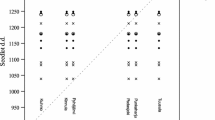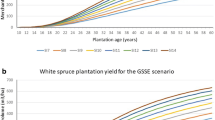Abstract
The financial viability of using improved seed material of Scots pine was assessed in Finnish conditions. Based on a few dozen field trials, a range of genetic gains for height growth was incorporated into a stand simulator. Technically genetic gain was modelled into individual growth models by applying the Chapman-Richards type function and using genetic gain estimates as asymptotic scaling parameters. Stand projections, including the effect of genetic gain, were further converted into monetary terms by calculating bare land values, i.e. BLVs according to the Faustman rotation model. Following this, the financial attractiveness of using improved seed material from Scots pine was determined by comparing the BLVs between stands with and without genetic gain. The study focused on the private forest owner’s point of view, reflecting the primary demand conditions for improved seed material. Comparisons between BLVs indicated that using improved seed material of Scots pine would be financially viable for private forest owners in most parts of Finland, the discount rate being 3%. The main results were robust, with pertinent changes in silvicultural costs and stumpage prices. This study demonstrates the need for financial analysis in decision-making in the context of regeneration material.

Similar content being viewed by others
References
Adams JP, Matney TG, Land SB, Belli KL, Duzan HW (2006) Incorporating genetic parameters into loblolly pine growth-and-yield model. Can J For Res 36:1959–1967
Ahtikoski A (2000) The profitability of Scots pine (Pinus sylvestris L.) and Silver birch (Betula pendula Roth) next-generation seed orchards in Finland. Department of Forest Economics, Research Papers 8. Dissertation, University of Helsinki
Ahtikoski A, Pulkkinen P (2003) Cost-benefit analysis of using orchard or stand seed in Scots pine sowing, the case of northern Finland. New For 26:247–262
Ahtikoski A, Päätalo ML, Niemistö P, Karhu J, Poutiainen E (2004) Effect of alternative thinning intensities on the financial outcome in silver birch (Betula pendula Roth) stands: a case study based on long-term experiments and MOTTI stand simulations. Balt For 10(2):46–55
Ahtikoski A, Alenius V, Mäkitalo K (2010) Scots pine stand establishment with special emphasis on uncertainty and cost-effectiveness, the case of northern Finland. New For 40(1):69–84
Andersson B, Elfving B, Persson T, Kroon J (2006) Characteristics and development of improved Pinus sylvestris in northern Sweden. Can J For Res 37:84–92
Anonymous (2006) Hyvän metsänhoidon suositukset. Metsätalouden kehittämiskeskus Tapio. Metsäkustannus Oy, Helsinki. 100 p. ISSN 1239-6117. [Silvicultural recommendations for good silviculture] [In Finnish]
Atwood RA, White TL, Huber DA (2002) Genetic parameters and gains for growth and wood properties in Florida source loblolly pine in the southeastern United States. Can J For Res 32:1025–1038
Berlin M, Danell Ö, Jansson G, Andersson B, Elfving B, Ericsson T (2009a) A model to estimate economic weight of tree survival relative to volume production taking patchiness into account. Scand J For Res 24:278–287
Berlin M, Jansson G, Danell Ö, Andersson B, Elfving B, Ericsson T (2009b) Economic weight of tree survival relative to volume production in tree breeding: a case study with Pinus sylvestris in northern Sweden. Scand J For Res 24:288–297
Buford MA, Burkhart HE (1987) Genetic improvement effects on growth and yield of loblolly pine plantations. For Sci 33:707–724
Carson SD, Carcia O, Hayes JD (1999) Realized gain and prediction of yield with genetically improved Pinus radiata in New Zealand. For Sci 45(2):186–200
EUR-Lex (1999) Articla 1, EUR-Lex. A Council Regulation (EC) No 2866/1998 of 31 of December 1998 on the conversion rates. An Internet web site (searched on 26th March 2010, from the URL: http://eur-lex.europa.eu/LexUriServ/LexUriServ.do?uri=CELEX:31998Y1231%2801%29:EN:HTML)
Fernandez-Perea MT, Jimenez RA (2004) Economic weights for selection index in Avileña purebred beef cattle. Livest Prod Sci 89:223–233
Finnish statistical yearbooks of forestry (1995 -2009) In Finnish with detailed English Summary. The books are also available in URL address: http://www.metla.fi/julkaisut/metsatilastollinenvsk/tilastovsk-sisalto.htm
Gould P, Marshall D (2010) Incorporation of genetic gain into growth projections of Douglas-fir using ORGANON and the forest vegetation simulator. West J Appl For 25(2):55–61
Gould P, Johnson R, Marshall D, Johnson G (2008) Estimation of genetic-gain multipliers for modeling Douglas-Fir height and diameter growth. For Sci 54(6):588–596
Gustavsen HG, Roiko-Jokela P, Varmola M (1988) Kivennäismaiden talousmetsien pysyvät (INKA ja TINKA) kokeet. Suunnitelmat, mittausmenetelmät ja aineistojen rakenteet. Metsäntutkimuslaitoksen Tiedonantoja, 292. Reports from the Finnish Forest Research Institute 292 [In Finnish]
Gwaze DP, Bridgewater FE, Williams CG (2002) Genetic analysi of growth curves for woody perennial species, Pinus taeda L. Theor Appl Genet 105:526–531
Hayes B, Goddard ME (2004) Break-even cost of genotyping genetic mutations affecting economic traits in Australian pig enterprises. Livest Prod Sci 89(2–3):235–242
Huuskonen S (2008) The development of young Scots pine stands–precommercial and first commercial thinning. Dissertationes Forestales 62. [in Finnish]
Huuskonen S, Ahtikoski A (2005) Ensiharvennuksen ajoituksen ja voimakkuuden vaikutus kuivahkon kankaan männiköiden tuotokseen ja tuottoon. Metsätieteen aikakauskirja 2: 99–115. [in Finnish]
Hynynen J, Ojansuu R, Hökkä H, Siipilehto J, Salminen H, Haapala P (2002) Models for predicting stand development in MELA System. Metsäntutkimuslaitoksen tiedonantoja – The Finnish Forest Research Institute, Research Papers 835, 116 p
Hynynen J, Ahtikoski A, Siitonen J, Sievänen R, Liski J (2005) Applying the MOTTI simulator to analyse the effects of alternative management schedules on timber and non-timber production. For Ecol Manage 207:5–18
Hyytiäinen K, Tahvonen O (2003) Maximum sustained yield, forest rent or Faustman: does it really matter? Scand J For Res 18:457–469
Jansson G (2007) Gains from selecting Pinus sylvestris in southern Sweden for volume per hectare. Scand J For Res 22:185–192
Jayawickrama KJS (2001) Potential genetic gains for carbon sequestration: e preliminary study on radiate pine plantations in New Zealand. For Ecol Manage 152:313–322
Kroon J, Andersson B, Mullin TJ (2008) Genetic variation in the diameter-height relationship in Scots pine (Pinus sylvestris). Can J For Res 38:1493–1503
Löfgren KG (1992) A note on the welfare gains from genetic progress in forestry: what can the market tell us? For Sci 38(2):479–483
Lu P, Charrette P (2008) Genetic parameter estimates for growth traits of black spruce in northwestern Ontario. Can J For Res 38:2994–3001
Mäkinen H, Hynynen J, Isomäki A (2005) Intensive management of Scots pine stands in southern Finland: First empirical results and simulated further development. For Ecol Manage 215:37–50
Miina J, Pukkala T, Hotanen JP, Salo K (2010) Optimizing the joint production of timber and bilberries. For Ecol Manage 259:2063–2071
Nikkanen T, Karvinen K, Koski V et al. (1999) Kuusen ja männyn siemenviljelykset ja niiden käyttöalueet. [Utilization areas of Scots pine and Norway spruce seed orchards in Finland]. Metsäntutkimuslaitoksen Tiedonantoja. Research Papers 730, Finnish Forest Research Institute. [In Finnish]
Pallett RN, Sale G (2004) The relative contributions of tree improvement and cultural practice toward productivity gains in Eucalyptus pulpwood stands. For Ecol Manage 193:33–43
Pesonen A, Eerikäinen K, Maltamo M, Tahvanainen T (2009) Models for predicting tree and stand development on larch plantations in Hallormsstaour, Iceland. New For 37:61–83
Petrinovic JF, Gelinas N, Beulieu J (2009) Benefits of using genetically improved white spruce in Quebec: the landowner’s viewpoint. For Chron 85:571–582
Pienaar LV, Turnbull KJ (1973) The Chapman-Richards generalization of von Bertalanffy’s growth model for basal growth and yield in even-aged stands. For Sci 19:2–22
Pohjola J, Valsta L (2007) Carbon credits and management of Scots pine and Norway spruce stands in Finland. For Pol Econ 9:789–798
Pukkala T (2009) Population-based methods in the optimization of stand management. Silva Fenn 43(2):261–274
Pulkkinen P (1994) Aerobiology of pollen. Dispersal of pollen from nonuniform sources and impact on Scots pine seed orchards. Reports from the Foundation of Forest Tree Breeding 8. Dissertation, University of Turku
Quinton VM, Wilton JW, Robinson JA, Mathur PK (2006) Economic weights for sow productivity traits in nucleus pig populations. Livest Sci 99:69–77
Rennolls K (1995) Forest height growth modelling. For Ecol Manage 71:217–225
Richards FJ (1959) A flexible growth function for empirical use. J Exp Bot 10(29):290–300
Salminen H, Lehtonen M, Hynynen J (2005) Reusing legacy FORTRAN in the MOTTI growth and yield simulator. Comp Elec Ag 49(1):103–113
Shifley SR, Brand GJ (1984) Chapman-Richards growth function constrained for maximum tree size. For Sci 30(4):1066–1070
Siipilehto J (2006) Linear prediction application for modelling the relationships between a large number of stand characteristics of Norway spruce stands. Silva Fenn 40(3):517–530
Siipilehto J (2009) Modelling stand structure in young Scots pine dominated stands. For Ecol Manage 257(1):223–232
Sprinz PT, Talbert CB, Strub MR (1989) Height-age trends from Arkansas seed source study. For Sci 35:677–691
Straka TJ (2010) Financial breakeven for competition control in longleaf pine (Pinus palustris Mill.) reestablishment. New For 40:165–173
Tonteri T, Hotanen JP, Kuusipalo J (1990) The Finnish forest site type approach: ordination and classification studies of mesic forest sites in southern Finland. Vegetatio 87:85–98
Venäläinen M, Hahl J, Pöykkö T (1996) Assessing the quality of young stems in predicting the total monetary yield of Scots pine progenies. Can J For Res 26:2227–2231
von Bertalanffy L (1957) Quantitative laws in metabolism and growth. Quart Rev Biol 32:217–231
Wagner JE, Holmes TP (1999) Estimating economic gains for landowners due to time-dependent changes in biotechnology. For Sci 45(2):163–170
Wilcox PL, Carson SD, Richardson TE, Ball RD, Horgan GP, Carter P (2001) Benefit-cost analysis of DNA marker-based selection in progenies of Pinus radiate seed orchard parents. Can J For Res 31:2213–2224
Xie CY, Yanchuk AD (2003) Breeding values of parental trees, genetic worth of seed orchard seedlots, and yields of improved stocks in British Columbia. West J Appl For 18:88–100
Yang Z, Cohen WB, Harmon ME (2005) Modeling early forest succession following clear-cutting in western Oregon. Can J For Res 35:1889–1900
Zhao-gang L, Feng-ri L (2003) The generalized Chapman-Richards function and applications to tree and stand growth. J For Res 14(1):19–26
Author information
Authors and Affiliations
Corresponding author
Rights and permissions
About this article
Cite this article
Ahtikoski, A., Ojansuu, R., Haapanen, M. et al. Financial performance of using genetically improved regeneration material of Scots pine (Pinus sylvestris L.) in Finland. New Forests 43, 335–348 (2012). https://doi.org/10.1007/s11056-011-9284-6
Received:
Accepted:
Published:
Issue Date:
DOI: https://doi.org/10.1007/s11056-011-9284-6




